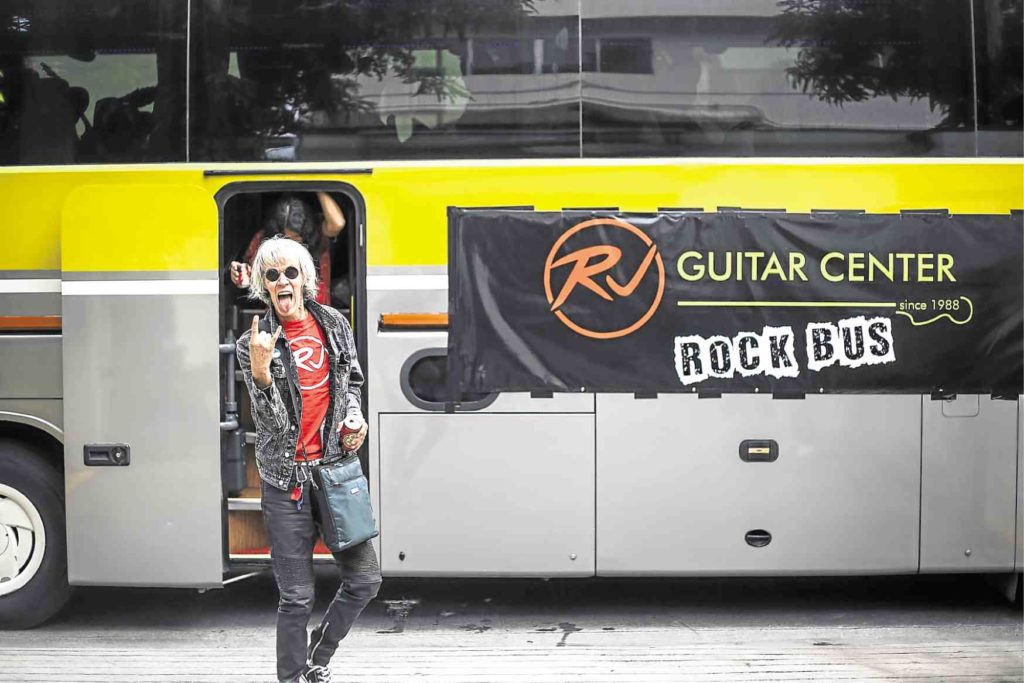
Pepe Smith alights the RJ Guitar Center Rock Bus in style at the company’s factory in Dasmariñas, Cavite.
With his tongue out and in an air guitar pose, Pinoy rock icon Pepe Smith described in one word (plus an expletive) what it felt playing the latest electric guitar recently launched by local manufacturer RJ Guitar Center: “Yeah!”
In the business of making these instruments since the late 1980s, RJ Guitar Center (Philippines) unveiled this month the Broadcaster, confidently branded the “Philippine standard,” said Ramon Jacinto II, the company’s president.
“This will be our top-of-the-line guitar,” Jacinto said. “[Smith] was actually one of the first people to try it out.”
“I’ve been playing with a lot of RJ [guitars] way, way back. They’re all fine. But when my hand touched that new guitar, p*tang ina,” Smith quipped.
Magical tour
Before the Broadcaster was officially launched at the RJ Bistro in Makati City, Smith, his band Drive Train, and other musicians such as Buwi Meneses of Parokya ni Edgar, Robin Nievera, Razorback’s Tirso Ripoll and Manuel Legarda, and Robby Mananquil and fiancee Maxene Magalona were first treated to a tour of where RJ guitars are born: the company’s 1,150-square-meter factory in Dasmariñas, Cavite.
(It was a bus ride that lasted almost six hours, including the trip back to RJ Bistro after the tour, but the traffic jam was no match for the musicians’ constant jamming, to the delight of the other passengers.)
The RJ Guitar Center factory is run in partnership with Japanese musical instruments manufacturer Deviser Co. Ltd., which makes Bacchus guitars, with the latter providing equipment and training for the RJ guitar factory.
For the past two years, RJ Guitar Center has been exporting mainly to Japan, “because it was a good fit, because we’re both guitar brands and we’re both in manufacturing, which doesn’t happen all the time,” said Jacinto.
“They needed another factory for their brands in Japan,” he added.
Ramon Jacinto II, RJ Guitar Center president, proudly showcases the locally made “Philippine standard” guitar, the Broadcaster.
RJ Guitar Center has been manufacturing for the past 30 years, but it was only recently that the company felt confident enough to start exporting, and eventually come up with a guitar labeled the Philippine standard, thanks to the partnership with Deviser.
“We were very, very proud that the Japanese accepted something Philippine-made. And so we thought, why don’t we have something like that here? We decided to push it forward … in the same way that you have an American standard and Japanese standard, you now have the Philippine standard,” Jacinto said.
Meticulous process
The guitar-making process begins with the most important part: Wood selection. Another thing RJ Guitar Center takes pride in is how all of its guitars are made from locally sourced wood.
After the wood is cut—with utmost precision, a skill learned from RJ Guitar’s Japanese partners—to make a guitar’s body and neck, the parts are sanded and painted by the factory’s over 170 workers before the product is finally assembled.
The factory produces around 800 guitars a month, said Jacinto.
The creation of the Philippine standard and its introduction to the market, said Jacinto, will hopefully put the country on the map as one of the world’s best guitar manufacturers. RJ guitars was the first Philippine brand to showcase two years ago at the National Association of Music Merchants (NAMM) show, the world’s No. 1 trade show for music instruments, and has also been featured in the Guitarist Magazine UK and HarmonyCentral.com.
Proud moment
“Before we did all that, we knew we had a great product, but you never know till you’re there. So when [our products] were accepted—and not only accepted, because the biggest criticism we got was, that’s all you’re selling it for?—it really, really made us proud,” said Jacinto. “The same way we feel this pride, we want people in the Philippines to change their thinking [about locally made guitars] and be proud also.”

